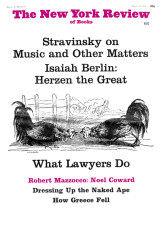In response to:
Emerson Behind Barbed Wire from the January 18, 1968 issue
To the Editors:
The basis for Lewis Mumford’s deep irritation with the Editors of Emerson’s Journals and Miscellaneous Notebooks, as I read his review of the six big volumes published since 1960, is that as a “faithful Emerson reader” rather than an “ac-credited Emerson scholar” he finds they have produced an “unreadable” edition, for specialized scholars only, whereas he wants a text affording “direct access” to Emerson’s extraordinary mind. His charge is double-barreled: the Editors include unimportant manuscript materials; and they make important journal entries difficult to read by including cancellations, substitutions, alternate readings within the text itself by means of brackets, arrows, and typographical symbols.
Since Mr. Mumford disqualifies himself as an Emerson scholar, there is small point in arguing the case for this kind of “diplomatic” text—though scholars have been making diplomatic texts for centuries and such texts have many justifiable scholarly uses. But the issue that the scholarly edition somehow prevents a selected reader’s edition in clear text is, fortunately, no issue at all. The Emerson Editors, from the beginning, have planned such an edition, and Harvard University Press plans to publish it. It will be of vital importance to readers like Mr. Mumford because it will be based on the full, accurate, unexpurgated scholarly edition, and it will represent the knowledge and taste of Emersonians quite as sensitive as Mr. Mumford is to Emerson’s fertile mind and original tongue. It will also be available for blind students and readers through Recording for the Blind, Incorporated. Mr. Mumford could not have known of this new reader’s edition—though I suppose he might sometime have inquired since his distaste for this scholarly edition began eight years ago when the first volume appeared. In the meanwhile, perhaps he ought to advise the Editors as to what he believes should be included in the new clear-text abbreviated edition. Peace to The New York Review, these men are not pedants, but are instead distinguished interpreters of the genius of Emerson and Melville who, among other things, are responsible for reliable texts of Melville’s letters and his Billy Budd, Sailor, a complete authoritative edition of Melville’s writings forthcoming, and a new edition of Emerson’s Works.
I wish also to challenge Mr. Mumford’s rather wild conclusion in his review that “American literary scholarship” holds that “the exact reproduction of the original text is a far more important undertaking than the sympathetic selection and arrangement of that text” for the benefit of intelligent non-academic readers. This is truly a non-issue, a wholly false dichotomy: there is no serious difference of opinion between Mr. Mumford’s view and the views of the Editors of new editions of major American writers now under way. So far as these editors represent “American literary scholarship,” they intend to establish and purify the full texts of major writers, setting forth the evidence for editorial choices at the end of the volumes and taking the steps that must be taken first before “sympathetic selection and arrangement” is possible. Mr. Mumford wants selection: the editors will give him total writings to select from, with no fine but obscure piece neglected or hidden. Mr. Mumford wants accurate unexpurgated texts, what the writer wrote and intended: so do the editors. Mr. Mumford wants sound inexpensive texts, as several remarks in his review concerning cost and expense suggest: so do the editors. Mr. Mumford especially wants the text uncluttered with revisions or footnote numbers or any kind of “barbed wire”: so do the editors.
I know because I am deeply involved with the group within the “American Literary Establishment” that backs the Emerson Journals and Miscellaneous Notebooks. The Center for Editions of American Authors, a program within the Modern Language Association, has received two major grants from the National Endowment for the Humanities, of which Barnaby C. Keeney is Chairman. With these funds, it backs editorial preparation—not publication costs—of authoritative editions of Emerson’s works and Emerson’s later lectures as well, of the Centenary Hawthorne, a new complete Thoreau, the Mark Twain Papers, a selected edition of Howells, Irving’s works, the Complete Writings of Whitman, and a new Stephen Crane; and it cooperates with the Editors of the North-western-Newberry edition of Melville and of the Iowa-California edition of Mark Twain’s printed writings, both of them funded by the Office of Education.
The point of all this editing is that all the editions named above, with the new edition of Emerson’s Journals, will appear in clear text—the text that Mr. Mumford favors and that Center editors favor as well, since it serves the interests of scholars and plain readers alike. I believe Mr. Mumford and perhaps many others will be interested to know that, by contract with the university presses publishing these editions, every text that has Endowment funds behind it will become available two years after publication to any responsible reprinting publisher for a modest fee. Similarly, since Mr. Mumford concludes his review with the assertion that the Harvard University Press edition of the Journals is “an expensive error,” he should know that editors who receive Center funds agree to forego royalties.
The Journals and Notebooks of Emerson are for scholars, just as the new multi-volume variorum Leaves of Grass will be for scholars. But the selected Emerson journals to come, the present Reader’s Edition of Leaves of Grass, the new Typee, Their Wedding Journey, and The Marble Faun, with a great many more volumes to come, are for literate readers now and in the future, here or anywhere.
William M. Gibson
Director
MLA Center for Editions of
American Authors
New York City
This Issue
March 14, 1968



